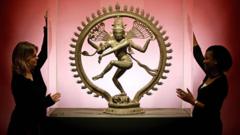In 1000 CE, a significant shift was occurring on the southern coast of India. While Europe was marked by instability, the Chola dynasty, led by King Rajaraja Chola, was on the verge of monumental architectural and cultural achievements. The temple he built, known as the Brihadishvara, is a UNESCO World Heritage site, standing 216 feet tall and constructed from 130,000 tonnes of granite, making it one of the tallest structures of its time. At its center lay a 12-foot figure of Shiva, adorned with gold and precious stones.
The Cholas, a powerful dynasty hailing from Tamil Nadu, were not just known for their impressive temples, but also for their strategic conquests that facilitated a significant transformation in the region’s political and economic landscape. Before the 11th Century, they were one among many regional powers; however, their exceptional drive for innovation set them apart. Chola queens, like Sembiyan Mahadevi, the aunt of Rajaraja, played pivotal roles as public figures and devotees of Shiva, enhancing the dynasty's reputation and popularity.
Rajaraja was not only an advocate of faith but also a formidable conqueror. In the late 990s, he expanded Chola territory by subduing adversaries and establishing a foothold in Lanka. His campaigns were not only about military conquest; they laid the foundation for what would become an urban and agricultural revolution in South India. Under his reign, the Brihadishvara temple received substantial annual donations, including 5,000 tonnes of rice, enabling it to serve as a center for public works and providing much-needed infrastructure across the region.
Rajaraja’s successor, Rajendra Chola, took expansion further, establishing connections with merchant groups and enhancing Tamil influence across Southeast Asia. In 1026, he sent forces to strategic maritime locales, such as Kedah, bolstering Chola trade networks that extended as far as China. The flourishing Tamil diaspora transformed into prominent merchants and traders, establishing vibrant trade centers across the Bay of Bengal.
The Cholas also fostered an eclectic cultural milieu. Their cities were melting pots where diverse cultures coexisted, seen in the blend of practices and arts that thrived during this era. Notably, Chola bronzes, particularly those depicting the dancing form of Nataraja, gained international acclaim and are celebrated in museums around the world, representing the advanced craftsmanship of Tamil artisans.
The Chola period marked a golden age of literature, architecture, and trade. The innovations, exchanges, and artistic developments of this time established Southern India as a significant hub in global history. Today, Tamil Nadu continues to reflect the legacies of the Chola dynasty, with many of its towns and communities rooted in temples and marketplaces that flourished during this remarkable era. Anirudh Kanisetti, an author and historian, emphasizes that the Chola dynasty's impact is still felt today, shaping the cultural and economic tapestry of modern South Asia.






















